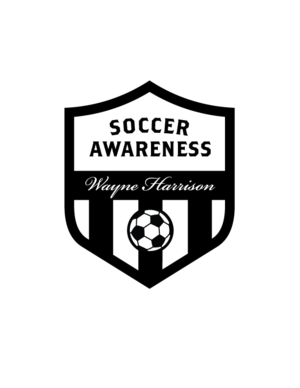Defensive Rotational Recovery Positions - Training Center Exclusive
/Due to our attacking rotations players are often out of position defensively when we lose the ball.
Here we show how players position to help each other and eventually work themselves back to their own natural positions on the team.
If they can learn this approach and understand how to cover for each other immediately this then really gives the team a wonderful means of attacking freedom and expression.
We are in attacking mode: both wing fullbacks attacking
This is our attacking set up we are attacking in numbers, we have players in different positions from their traditional ones because we allow freedom of rotation. But here (8) passes to (10) but the ball is intercepted by opponent's player (A). Not enough room to put all opponent's players in but you get the idea.
We attack and lose the ball
We lose the ball to player (A) who plays it forward to player (E). Now showing the start positions for the recovery and changing of positions depending on where the ball is played. This shows their positions initially and where they will move to. Its imperative (4) delays (E).
We condense our defensive shape
This shows them after they have moved into their new defensive positions. Player positioning is now different defensively but it doesn’t matter as long as we can create our defensive shape which we have. Players recover in straight lines or the shortest route back to goal; or to the ball.
How we press and recover and who does what, where and why?
Changes: Our Center back (4) is now a left wing fullback (3); our central defender (6) is a left center back (5); our left defender (5) is a central defender or deep defensive midfielder (6); our left back (3) is a center midfielder (8), our central midfield (8) is now defensive midfielder (6); our right wing fullback (2) is a right midfielder (7); our striker (9) is a number (10); our attacking midfielder (10) is in the wide left (11) position (and double teaming) and our wide left (11) is in the (9) position.
Changes in previous diagrams:
To recap on the previous defensive recovery set up which was our offensive set up initially:
Our Center back (4) is now a left fullback 3;
Our defensive midfielder (6) is now a left center back 5;
Our right center back (5) is the same (or a deep lying number 6 position);
Our linking midfielder (8) is a defensive midfielder 6;
Our left back (3) is a center midfielder 8,
Our striker (9) is now a number 10;
Our attacking midfielder (10) is in the wide left position 11 and double teaming;
Our wide left striker (11) is in the (9) central striker position;
Our right fullback (2) is in 7s wide striker position but tucking in;
Our wide right striker (7) is in right fullback 2s position.
How we press and recover and who does what, where and why?
Ball goes out of play, for example, the players then rotate back into their own positions; or any part of the game they have time to do this they must try to work back into their own positions. Here we are playing with the defensive midfielder (6) in behind the center backs but could also have him or her in front per the norm.
The Moral of this?
In developing and actively encouraging a team to play with incredible freedom and fluididity within the team framework set by the coach; we must also address what can go wrong defensively using this method of playing.
It can leave us vulnerable to a counter attack especially.
Through the freedom of movement players are often out of their own positions and may feel a little lost if we lose the ball as to where they need to go next?
Often; for example: a fullback will attack up and down the field making a 50 yard run but dreading the 50 run back to their position if we lose the ball.
If this is not addressed with the fullback; then that fullback may be less effective offensively; as the thought of all the recovery runs may put them off, plus it may also be too physically challenging for them over the course of a full game.
By showing here how players can compensate for this, how to cover for each other, how to save energy; it will therefore encourage them to continue with their offensive style knowing they know how best to defend if they lose the ball.
And then that PERCEIVED WEAKNESS in the system of play may in fact be transformed into a REAL STRENGTH of the team.
To make this work though we need a team of UNSELFISH PLAYERS PREPARED TO WORK AND HELP EACH OTHER.
COACHES SHOULD SET THESE SITUATIONS UP IN TRAINING TO SHOW THE PLAYERS WHO DOES WHAT AND WHEN.
ATTACKING SHAPE, WITH MANY INTERCHANGES, THEN STOP THE ACTION, THROW ANOTHER BALL INTO THE OPPONENTS; AND THEN HAVE THEM STAND STILL IN POSITION; GIVING OUR TEAM TIME TO SEE HOW THEY CAN POSITION DEFENSIVELY IMMEDIATELY THEY LOSE THE BALL.
ONCE THEY CAN SEE HOW TO DO IT THEN MAKE IT LIVE AGAIN; AND THEN LET IT GO FREE.
















